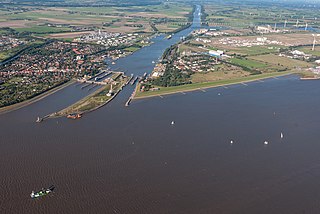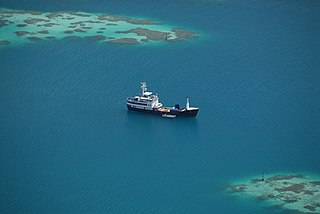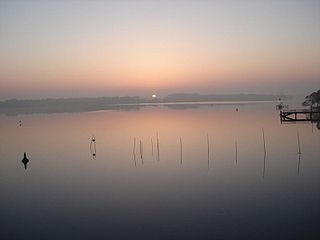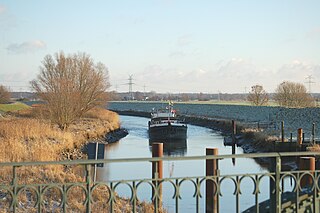Related Research Articles

The Kiel Canal is a 98 km (61 mi) long freshwater canal in the German state of Schleswig-Holstein. The canal was finished in 1895, but later widened, and links the North Sea at Brunsbüttel to the Baltic Sea at Kiel-Holtenau. An average of 460 km (290 mi) is saved by using the Kiel Canal instead of going around the Jutland Peninsula. This not only saves time but also avoids storm-prone seas and having to pass through the Danish straits.

The Elbe–Lübeck Canal is an artificial waterway in eastern Schleswig-Holstein, Germany. It connects the rivers Elbe and Trave, creating an inland water route across the drainage divide from the North Sea to the Baltic Sea. The canal includes seven locks and runs for a length of 64 kilometres (40 mi) between the cities of Lübeck in the north and Lauenburg in the south by way of the Mölln lakes. The modern canal was built in the 1890s to replace the Stecknitz Canal, a medieval watercourse linking the same two rivers.

The Moselle is a river that rises in the Vosges mountains and flows through north-eastern France and Luxembourg to western Germany. It is a left bank tributary of the Rhine, which it joins at Koblenz. A small part of Belgium is in its basin as it includes the Sauer and the Our.

is a lake in Mecklenburg-Vorpommern, Germany, located at 53°27′57″N12°18′27″E. Its surface is approximately 38.4 km2 and its maximum depth is 25.5 metres (84 ft).

The Wasserschutzpolizei is the river police that patrols the waterways, lakes and harbours of Germany around the clock. The WSP are part of the Landespolizei. The Federal Police maintains 16 patrol craft and helicopters are part of the Coast Guard (Küstenwache) and assigned to coastal BPOL stations. The watercraft include six offshore patrol vessels, e.g. those of the Bad Bramstedt class, as well as a number of fast inshore vessels and one tugboat.

The Müritz is a lake in Mecklenburg-Vorpommern, northern Germany. Its area is 117 km2 (45 sq mi), which makes it the second largest lake in Germany and the largest lake located entirely within German territory.

YWAM Koha is a New Zealand-registered Medical Aid Ship, built in 1968 as the buoy tender Konrad Meisel for the German Government and later owned in South Africa as Isibane. As the Claymore II she provided the essential transport links to the remote Pacific territory of Pitcairn Island from New Zealand and French Polynesia, part-funded by the British Government until 2018 when she was replaced by the Silver Supporter.
The icebreakers of Germany include one large icebreaker, used for International polar research and dozens of smaller icebreakers that clear navigation channels of ice in Germany's territorial waters.

Plauer See is a lake in the state of Brandenburg, Germany. It is situated to the west of the city of Brandenburg an der Havel, and is one of a number of directly linked lakes, along with the Breitlingsee, Möserscher See, Quenzsee and Wendsee.

Wendsee is a lake in the state of Brandenburg, Germany. It is situated to the west of the city of Brandenburg an der Havel, and is one of a number of directly linked lakes, along with the Breitlingsee, Möserscher See, Plauer See, and Quenzsee. The lake has a surface area of 80 hectares, and has a maximum depth of 4.9 metres (16 ft).

The Silo Canal, or Silokanal in German, is a canal in the German state of Brandenburg. It provides a short cut for vessels navigating the River Havel, avoiding the winding and constricted navigation through the city of Brandenburg an der Havel.

The Brandenburg City Canal, or Brandenburger Stadtkanal in German, is a canal in the German state of Brandenburg. It provides a 4-kilometre (2.5 mi) route through the centre of the city of Brandenburg an der Havel.
The Osnabrück Canal or SKO, is an artificial waterway, about 14.5 kilometres (9 mi) long, that links the Mittelland Canal in central Germany with the port in the town of Osnabrück. It was built between 1910 and 1915 and runs largely parallel to the unnavigable River Hase, the greatest distance between the two being about 1 kilometre (0.6 mi).
The Keiler is a river icebreaker commissioned in December 2011 to serve as the flagship of Lauenburg's Water and Shipping Authority fleet of ten icebreakers, on the Elbe River. The vessel is 33.21 metres (109.0 ft) long and 8.45 metres (27.7 ft) wide. She has a crew of four, and has sleeping and dining accommodation for operations that take longer than a single shift.

Frankfurt is a prototype river icebreaker constructed by Hitzler Werft for icebreaking duties on the Elbe River, Oder River, and canals in Germany, operated by the Wasser und Schifffahrtsamt Eberswalde. She was built in 2002. Three further vessels, built to a similar design, were ordered by the Wasser und Schifffahrtsamt in 2009.

The Rheinsberg Lake Region with its many great and small lakes, lies in the richly-varied, gently rolling, forested countryside between the villages of Rheinsberg, Menz and Fürstenberg/Havel in the north German state of Brandenburg. It lies just to the south of the Neustrelitz Little Lakes Region, but has no natural link to the waterbodies to the north. However, the Rheinsberg Lake Region is linked to the Neustrelitz lakes via the Wolfsbruch Canal and Lock, the Müritz-Havel Waterway and the Upper Havel Waterway. It drains southwards to the River Havel through the Rhin and is bounded by Ruppin Switzerland to the south. The overwhelming part of the region belongs to the Stechlin-Ruppiner Land Nature Park. The Stechlin Nature Reserve, created in 1938, is well known.

The Elster-Saale Canal, renamed in 1999 by the Federal Waterways and Shipping Administration to Saale-Leipzig Canal or SLK and on the Halle side also called Saale-Elster Canal, was a canal project started in 1933 and aborted in 1943. It was intended to link the White Elster river with the Saale near Leuna and thus enable the city of Leipzig to be joined to Germany's inland waterway network. The 11 kilometre long water-filled channel is one of the "special federal waterways".

The Pinnau is a 41-kilometre-long (25 mi) river, which flows right or northeast of the main river, Elbe. The Pinnau is therefore a tributary in the southern part of Schleswig-Holstein, Germany.
Eversand is a support vessel in service with Van Laar Maritime in the North Sea. It served most of its career for the Waterways and Shipping Authority of Bremerhaven, Germany.

Kupfergraben is the name given to the 400-metre-long northern part of the canal-like left arm of the Spree, the Spreekanal, along the Museum Island (Museumsinsel) from the Eiserne Bridge to the Spree at kilometre 16.31 in Berlin's Mitte district. The Spreekanal (SpK) with a length of two kilometres belongs to the federal waterway Spree-Oder-Wasserstraße, for which the Wasser- und Schifffahrtsamt Berlin is responsible.
References
- ↑ "Wir über uns" [About us] (in German). Wasser- und Schifffahrtsverwaltung des Bundes. Retrieved 28 June 2014.
- ↑ "Auswahl der Außenstelle über Karte" [Map showing WSAs] (in German). Wasser- und Schifffahrtsverwaltung des Bundes. Retrieved 28 June 2014.
- ↑ "Zuständigkeitsbereich" [Area of responsibility] (in German). Wasserstraßen- und Schifffahrtsamt Elbe. Retrieved 26 October 2023.
- ↑ "Zuständigkeitsbereich" [Area of responsibility] (in German). Wasserstraßen- und Schifffahrtsamt Main. Retrieved 26 October 2023.
- ↑ Timo Jann (18 December 2011). "Der neue Star der Eisbrecher-Flotte" [The new star of the icebreaker fleet] (in German). Lübecker Nachrichten. Archived from the original on 6 January 2013. Retrieved 10 January 2012.
- ↑ "Lauenburger Hitzler-Werft übergibt neuen Eisbrecher an das Wasser und Schifffahrtsamt" [Hitzler shipyard of Lauenburg hands over new icebreaker to the Waterways and Shipping Office](PDF) (in German). Wasser- und Schifffahrtsamt Lauenburg. Archived from the original (PDF) on 11 January 2012. Retrieved 10 January 2012.
- 1 2 Timo Jann (18 May 2010). "Bei "Kietz" fehlt nur der Feinschliff" ["Kietz" missing only the finishing touches] (in German). Bergedorfer Zeitung . Retrieved 10 January 2012.